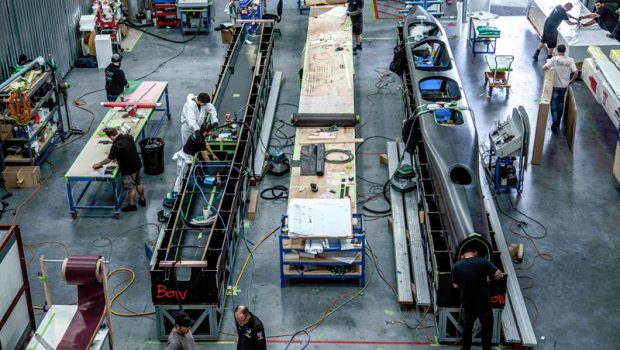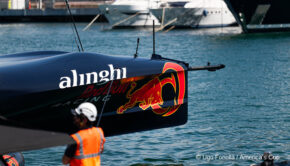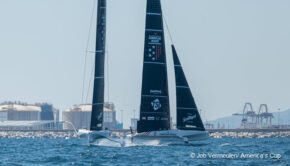Trickle Down to Other Sports
Published on May 9th, 2017
Southern Spars have had a hand in creating Team New Zealand boats for the last six America’s Cup campaigns, and are notably a dominant mast and rigging supplier for the sport. But marine companies need to remain agile, and as Suzanne McFadden reports, Southern Spars is finding their talents extend to other sports as well.
They built the fastest America’s Cup yacht that New Zealand has ever sailed, and the wheels that transported Kiwi cyclists to six Olympic and world championship medals. Now Auckland mast-makers Southern Spars want to help more New Zealand athletes on to the winners’ podium, by taking their cutting-edge technology in ingenious new directions.
Maybe it will be Eliza McCartney’s vaulting pole; the New Zealand eight’s rowing oars; Luuka Jones’s slalom canoe; or even Liam Malone’s running blades. Southern Spars want to look at any sporting equipment that could be made from lightweight, strong and reliable carbon, and apply their design and construction expertise to it.
“Because of the way we think and design, we could really add value and give these athletes an edge,” says Southern Spars director Mark Hauser. “New Zealanders think a little differently from the rest of the world. That’s why we come up with boats with cyclists on them.”
For almost three decades, Southern Spars have been world leaders in designing and manufacturing masts and rigging for yachts around the world. Their history stretches back to Sir Peter Blake’s all-conquering round-the-world race yacht Steinlager II, in 1989, and Team New Zealand’s victorious Black Magic boats in 1995. When the America’s Cup was raced in Auckland in 2000 and 2003, the New Zealand company made all the masts in the fleet.
In this America’s Cup, which starts in Bermuda in three weeks’ time, Southern Spars have broadened their horizons and painstakingly built Emirates Team New Zealand’s ACC yacht, from the wing sail, to the twin hulls, right down to the hydrofoils.
But this latest change in tack began with a different sport – when Olympic rowing gold medallist and former America’s Cup sailor Rob Waddell walked into Hauser’s office inside the sprawling Southern Spars factory early last year, armed with a couple of oars.
Waddell, chef de mission for the New Zealand Olympic team in Rio, wanted to see if Southern Spars could design a better oar for the rowing team.
“We started going down that path of development, but with only six months until the Olympics, there wasn’t enough time,” Hauser recalls. “So, then he came back with a bike wheel.”
Some of the 22 designers who work at Southern Spars’ new headquarters in Avondale cut the aerodynamic wheel in half, and knew straight away they could make it significantly lighter and stiffer than the wheels being used by New Zealand’s top track cyclists. They worked with data from Cycling New Zealand and the Goldmine team of engineers at High Performance Sport NZ.
“We started to create a wheel that was pretty complex, but we didn’t quite get there with it,” Hauser says. That technology has been put to the side, to be further developed. But in the meantime, the designers still devised a new and improved wheel for the Olympic-bound riders.
They sent 32 of the black carbon fibre wheels with the team to Rio, where the New Zealand men’s sprint trio rode faster than they had ever done before, to win the silver medal.
“After the Olympics, [Cycling New Zealand] locked the wheels away; they thought they had something special, technology that they should save,” Hauser says. The wheels came out again for last month’s world championships in Hong Kong – and won five medals, including gold in the team sprint.
Rob Waddell says the wheel development has given Kiwi cyclists an obvious performance edge over their rivals.
“It’s a great New Zealand success story. At the end of the day, the main beneficiary was the athlete sitting on the start-line knowing they had a better product,” he says.
“But the partnership has worked well for Southern Spars too – being able to use their design and manufacturing expertise to do something different, that aligned with their strengths. And now a lot of people have learned that we have one of the very best centres of composite technology in the world sitting here in Auckland.
“When I saw what was achieved in a very short time for Rio, I knew it was just scratching the surface. There’s a lot more we could be doing with their expertise for other New Zealand sports to benefit. I guess we could look at anything that has a carbon component.”
Before Southern Spars had delivered the wheels to the Kiwi cyclists, Hauser got a call from Team NZ’s COO, Kevin Shoebridge. The contract to build the campaign’s single ACC catamaran was up for grabs.
“I’d always been banging on their door to let us do more,” says Hauser. “Although there’s always plenty going on here, we could make room for it. To be honest, we’d do anything to help Team New Zealand get that Cup away from the Americans and bring it back here.”
Building one of these high-powered, precision yachts – now teetering on the brink of breaking 50 knots an hour in speed – wasn’t too far out of Southern Spars’ comfort zone.
“If you look at these boats, their parts are basically long narrow things, like a mast or a boom. This whole factory is set up for long skinny things.”
Everything in the new 10,000 sqm Southern Spars building in west Auckland is big. The 52m long autoclave – a giant oven to bake carbon composites – and a 62m long paint booth – where both 15 meter ACC hulls could be lined up end-to-end – are the longest of their kind in the Southern Hemisphere. It is also a place of exacting precision – every millimetre of paint was measured for every coat on the Team NZ boat to meet the tight weight specifications.
Making the boat’s hulls, which are all an identical design for this America’s Cup, was far from the most complicated part of the job. The two complex wing sails took 15,000 man hours to complete; the rest of the boat, just 14,000.
Hauser says he and the Southern Spars staff (up to 300 in Auckland) were kept in the dark about Team NZ’s plan to install pedals and bike seats to power the boat. “Whenever I turned up at their base, [Olympic cyclist now grinder] Simon van Velthooven would have to go hide out the back. I saw the sailors’ body shapes change, but I honestly had no idea. I think it’s great; there’s a lot to it.”
Masts are still the company’s core business – from superyachts to Olympic dinghies. They’re now making spars for all eight boats in this year’s round-the-world Volvo Ocean Race. Around 1000 people are employed throughout their manufacturing and servicing facilities in Auckland, South Africa, Sri Lanka, Spain, Denmark and the United States.
But the pedal-powered catamaran and the cycling wheels have “opened a lot of doors” for Southern Spars, as they continue to look for more composite work outside their norm. They’ve been building carbon parts for Pacific Aerospace in Hamilton, to help reduce weight in their planes.
“We’d like to do a lot more composite work – aircraft, helicopters, bridges – and we’re keen to help make the SkyPath under the Auckland Harbour Bridge,” Hauser says. “We see ourselves as being strong in top-end composites, and there’s a big demand for them out there.”









 We’ll keep your information safe.
We’ll keep your information safe.